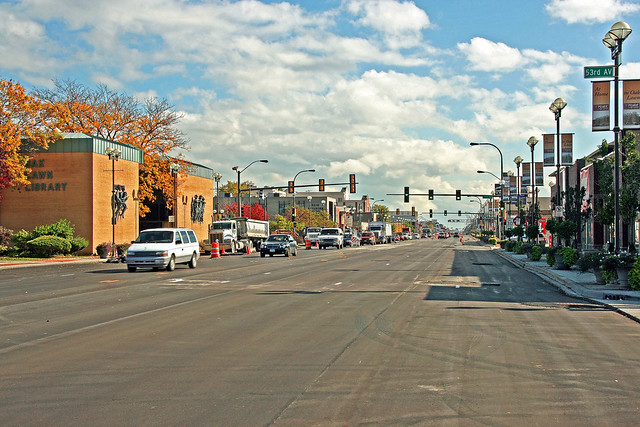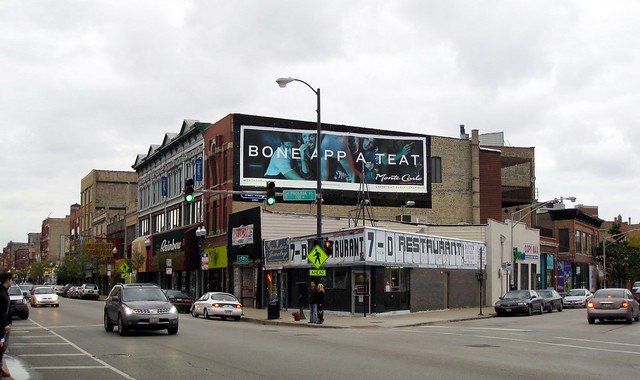A recent decision by Illinois's 1st District Court of Appeals could make it harder to hold city governments and individual drivers accountable for pedestrian safety.
The ruling by Justice Sheldon Harris [PDF] concerns a case in a which pedestrian was struck and killed by a driver on 95th Street in Oak Lawn. By creating a new legal precedent with a restrictive view of people's right to walk in unmarked crosswalks, the ruling could have serious implications for pedestrian safety in the eyes of the law.
On November 9, 2009, Joan Orth, 51, was crossing 95th Street at Kenton Avenue at around 5:45 p.m. in the Village of Oak Lawn. Before she could get to the other side of the street, a driver struck and killed her. Diane Dunet, Orth's estate administrator, filed lawsuits against Oak Lawn as well as ComEd because nearby streetlights weren't working at the time.
The village and ComEd denied responsibility and the case was thrown out. Oak Lawn said it didn't owe anything, arguing that Orth "was not an intended and permitted user of the street where the accident occurred" because there was no marked crosswalk, according to the ruling. The village government also argued that the darkened street lights didn't cause the crash but "presented an opportunity" for it, adding that the crash was the fault of the driver of the vehicle who struck Orth, for which Oak Lawn could not be held liable.
A look at a satellite image of the intersection taken on November 23, 2009 (see map below), confirms there is an unmarked crosswalk across 95th Street, which has six travel lanes and two parking lanes. Orth was struck in a westbound lane, near the center of the street. Attorneys say that Flanagan's ruling sets a precedent that could weaken the legal protections for everyone using unmarked crosswalks in Cook County.
This case is a little hard to wrap your head around, but the important precedent hinges on the following three concepts that attorney Jim Freeman helpfully explained:
- Permitted user: Oak Lawn argued that Orth wasn't a permitted user. This refers to someone who is "allowed to use the infrastructure," said Freeman, "but you can't sue a local governmental entity if you are injured as a result of such use because you are not an intended user."
- Intended user: "Intended users are the traveling public for which a given piece of infrastructure was intended. Cars are intended users of almost all streets," Freeman said.
- Unmarked crosswalk: A pedestrian can cross the street in marked crosswalks and "in" unmarked crosswalks. Without distinguishing between the two types of crosswalks, the Illinois Compiled Statutes says that a crosswalk is present wherever a sidewalk leads into a street, regardless of whether there is a sidewalk on the other side.
Nonetheless, the ruling said that the portion of the street where Orth crossed was not intended for pedestrians, even though it was an unmarked crosswalk. Referring to the initial decision by a lower court, Harris wrote:
The circuit court further noted that the existence of marked crosswalks, complete with traffic lights and sloped curbs, at the adjacent intersections [emphasis added] to the intersection at issue here, indicates that the area where decedent crossed the street was not intended for pedestrians.
In other words, the victim was allowed to use the unmarked crosswalk, but she shouldn't have.
What's so bad about this? Attorney Brendan Kevenides originally brought the case to my attention, and he said local municipalities may see the ruling as absolving them of their responsibilities to people crossing in an unmarked crosswalk because it "creates a powerful legal precedent" which could guide lower courts in Illinois. "In determining whether a pedestrian is an intended user of a stretch of roadway, the court places undue emphasis on whether the crosswalk, where people should cross the street, has been marked with painted lines" even though the Illinois Vehicle Code recognizes that not all crosswalks are marked, Kevenides explained:
I fear that an unintended consequence of this decision may be that a pedestrian injured due to the dangerous condition of an unmarked crosswalk may be left with no recourse against the municipality responsible for maintaining that crosswalk. Even in a case in which a pedestrian is hit by a driver while walking in an unmarked crosswalk, I could see a court using this decision to dismiss the case against the driver on the ground that the pedestrian was in a placed he or she was not intended to be.
Imagine if everyone treated this ruling literally and only crossed streets at marked crosswalks with traffic lights and sloped curbs. Walking journeys would get much longer and more complicated. Assuming Orth's destination was south of 95th Street along Kenton Avenue (she lived at 9500 S Kolmar), walking to the nearest signalized intersection with ramped curbs would have added half a mile to her trip:
9500 South Kenton in Oak Lawn.
Should we now expect municipalities to produce maps of all the intersections with (1) crosswalk striping, (2) stoplights, and (3) curb cuts, so we'll know the intended places to cross? I know of several intersections just in Chicago that meet one or two of these qualifications, but not all three. For example, Milwaukee/Paulina has a traffic stoplight with pedestrian countdown signals, but it's missing marked crosswalks and curb cuts on two of the three crossings. The pedestrian signal is telling you to cross, but Justice Harris is saying you shouldn't -- and if you do, motorists can run you down with impunity.
Ron Burke, director of the Active Transportation Alliance, said his organization shares some of the same concerns as Kevenides but is talking to more experts to analyze what the effects may be. "After consulting with some other attorneys, if it turns out that this is really problematic, then we will explore a legislative strategy to address this."
Ed. note: Both Freeman and Kevenides are sponsors of Streetsblog Chicago.






